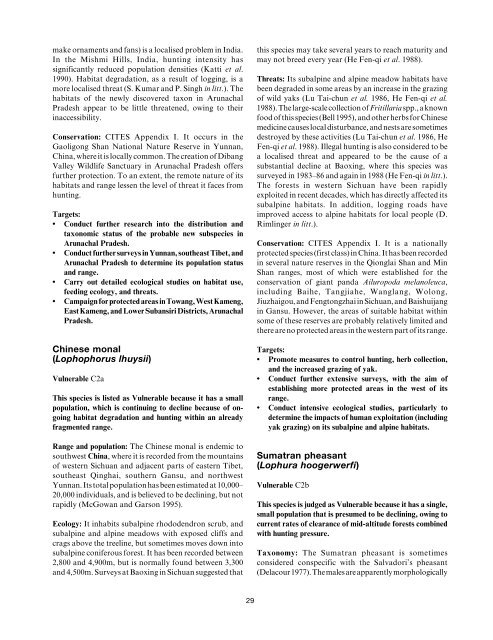Pheasants: Status Survey and Conservation Action Plan ... - IUCN
Pheasants: Status Survey and Conservation Action Plan ... - IUCN
Pheasants: Status Survey and Conservation Action Plan ... - IUCN
Create successful ePaper yourself
Turn your PDF publications into a flip-book with our unique Google optimized e-Paper software.
make ornaments <strong>and</strong> fans) is a localised problem in India.<br />
In the Mishmi Hills, India, hunting intensity has<br />
significantly reduced population densities (Katti et al.<br />
1990). Habitat degradation, as a result of logging, is a<br />
more localised threat (S. Kumar <strong>and</strong> P. Singh in litt.). The<br />
habitats of the newly discovered taxon in Arunachal<br />
Pradesh appear to be little threatened, owing to their<br />
inaccessibility.<br />
<strong>Conservation</strong>: CITES Appendix I. It occurs in the<br />
Gaoligong Shan National Nature Reserve in Yunnan,<br />
China, where it is locally common. The creation of Dibang<br />
Valley Wildlife Sanctuary in Arunachal Pradesh offers<br />
further protection. To an extent, the remote nature of its<br />
habitats <strong>and</strong> range lessen the level of threat it faces from<br />
hunting.<br />
Targets:<br />
• Conduct further research into the distribution <strong>and</strong><br />
taxonomic status of the probable new subspecies in<br />
Arunachal Pradesh.<br />
• Conduct further surveys in Yunnan, southeast Tibet, <strong>and</strong><br />
Arunachal Pradesh to determine its population status<br />
<strong>and</strong> range.<br />
• Carry out detailed ecological studies on habitat use,<br />
feeding ecology, <strong>and</strong> threats.<br />
• Campaign for protected areas in Towang, West Kameng,<br />
East Kameng, <strong>and</strong> Lower Subansiri Districts, Arunachal<br />
Pradesh.<br />
Chinese monal<br />
(Lophophorus lhuysii)<br />
Vulnerable C2a<br />
This species is listed as Vulnerable because it has a small<br />
population, which is continuing to decline because of ongoing<br />
habitat degradation <strong>and</strong> hunting within an already<br />
fragmented range.<br />
Range <strong>and</strong> population: The Chinese monal is endemic to<br />
southwest China, where it is recorded from the mountains<br />
of western Sichuan <strong>and</strong> adjacent parts of eastern Tibet,<br />
southeast Qinghai, southern Gansu, <strong>and</strong> northwest<br />
Yunnan. Its total population has been estimated at 10,000–<br />
20,000 individuals, <strong>and</strong> is believed to be declining, but not<br />
rapidly (McGowan <strong>and</strong> Garson 1995).<br />
Ecology: It inhabits subalpine rhododendron scrub, <strong>and</strong><br />
subalpine <strong>and</strong> alpine meadows with exposed cliffs <strong>and</strong><br />
crags above the treeline, but sometimes moves down into<br />
subalpine coniferous forest. It has been recorded between<br />
2,800 <strong>and</strong> 4,900m, but is normally found between 3,300<br />
<strong>and</strong> 4,500m. <strong>Survey</strong>s at Baoxing in Sichuan suggested that<br />
this species may take several years to reach maturity <strong>and</strong><br />
may not breed every year (He Fen-qi et al. 1988).<br />
Threats: Its subalpine <strong>and</strong> alpine meadow habitats have<br />
been degraded in some areas by an increase in the grazing<br />
of wild yaks (Lu Tai-chun et al. 1986, He Fen-qi et al.<br />
1988). The large-scale collection of Fritillaria spp., a known<br />
food of this species (Bell 1995), <strong>and</strong> other herbs for Chinese<br />
medicine causes local disturbance, <strong>and</strong> nests are sometimes<br />
destroyed by these activities (Lu Tai-chun et al. 1986, He<br />
Fen-qi et al. 1988). Illegal hunting is also considered to be<br />
a localised threat <strong>and</strong> appeared to be the cause of a<br />
substantial decline at Baoxing, where this species was<br />
surveyed in 1983–86 <strong>and</strong> again in 1988 (He Fen-qi in litt.).<br />
The forests in western Sichuan have been rapidly<br />
exploited in recent decades, which has directly affected its<br />
subalpine habitats. In addition, logging roads have<br />
improved access to alpine habitats for local people (D.<br />
Rimlinger in litt.).<br />
<strong>Conservation</strong>: CITES Appendix I. It is a nationally<br />
protected species (first class) in China. It has been recorded<br />
in several nature reserves in the Qionglai Shan <strong>and</strong> Min<br />
Shan ranges, most of which were established for the<br />
conservation of giant p<strong>and</strong>a Ailuropoda melanoleuca,<br />
including Baihe, Tangjiahe, Wanglang, Wolong,<br />
Jiuzhaigou, <strong>and</strong> Fengtongzhai in Sichuan, <strong>and</strong> Baishuijang<br />
in Gansu. However, the areas of suitable habitat within<br />
some of these reserves are probably relatively limited <strong>and</strong><br />
there are no protected areas in the western part of its range.<br />
Targets:<br />
• Promote measures to control hunting, herb collection,<br />
<strong>and</strong> the increased grazing of yak.<br />
• Conduct further extensive surveys, with the aim of<br />
establishing more protected areas in the west of its<br />
range.<br />
• Conduct intensive ecological studies, particularly to<br />
determine the impacts of human exploitation (including<br />
yak grazing) on its subalpine <strong>and</strong> alpine habitats.<br />
Sumatran pheasant<br />
(Lophura hoogerwerfi)<br />
Vulnerable C2b<br />
This species is judged as Vulnerable because it has a single,<br />
small population that is presumed to be declining, owing to<br />
current rates of clearance of mid-altitude forests combined<br />
with hunting pressure.<br />
Taxonomy: The Sumatran pheasant is sometimes<br />
considered conspecific with the Salvadori’s pheasant<br />
(Delacour 1977). The males are apparently morphologically<br />
29
















